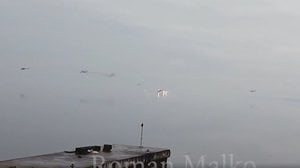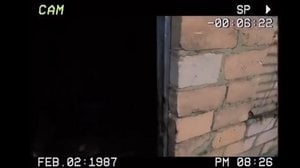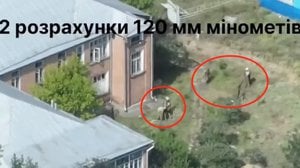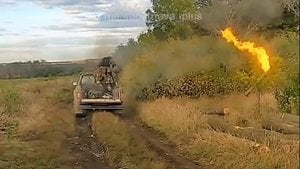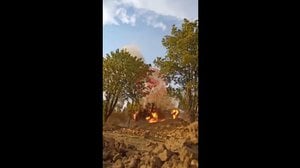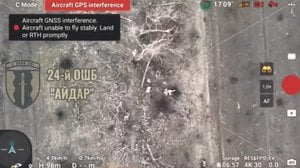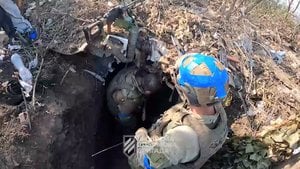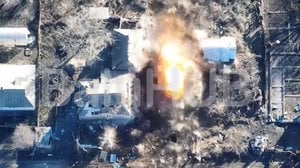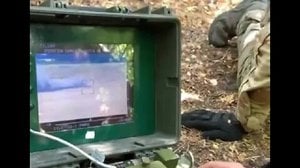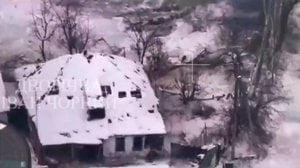
Magura Brigade Crushes Russian Assault Near Avdiivka
Published 6 months ago
If you seek a military force that is inept and disdainful of its soldiers, look no further than the Russian Army. This edited drone footage from Ukraine’s 47th Mechanized “Magura” Brigade shows a failed Russian mechanized attack on the Ukrainian salient at Avdiivka. In this ninety second clip we see Russian armor destroyed as they advance toward their objective, but the video tells us so much more about the Russian military, which continues to experience issues with command and control, and which has failed to capture lessons from previous debacles.
The video opens with a tank and a BTR passing forward past a staggered column of stationary vehicles, a few of which seem as though they might be disabled. Patches of smoke drift across a shell-pocked landscape littered with the detritus of multiple failed assaults. As the column presses forward past the skeletal remains of a tree line, the third vehicle in line suddenly explodes, cause unknown. As the column continues the second vehicle, a BTR, fires at an unseen target as the tank to its rear also explodes. The lead tank and BTR roll on, and we are afforded a view of the tank firing on the move just before it is nailed by an FPV drone which produces a spectacular explosion. The BTR charges past the shattered tank, guns blazing, until it also vanishes in a pillar of smoke and flame. The attack is done.
This footage is indicative of Russian offensive operations around Avdiivka over the past several weeks. Early in October, the Russian Army launched an offensive against a Ukrainian salient in their lines, centered on the mining town which at one point was home to over 31,000 people. The Russians were able to mass forces undetected and their initial attack achieved some measure of surprise, but it quickly stalled as mines, ATGMs, timely and accurate Ukrainian fires, and swarms of drones crushed advancing waves of armor and disrupted supplies and reinforcements behind the lines. The Institute for the Study of War estimates that Russian units have studied at least 197 armored vehicles damaged or destroyed, including as many as 99 tanks and armored vehicles in the first four days. The Atlantic Council estimates that Russia threw at least eight brigades into the battle, with personnel losses in the thousands and many of those units no longer combat effective. The pace of attacks has slowed in recent days with an increase in indirect fire, likely preparation for renewed assaults. Ukrainian sources predict that vehicle losses will force the Russians to shift tactics, resorting instead to “meat attacks,” frontal infantry assaults led by Storm-Z units consisting of convicts.
This unceasing self-immolation is indicative of several failures on the part of the Russian Army. Previous posts by this account have noted that the units which are kept in the line without respite has resulted in fatigue amongst assault formations. Combat losses are replaced by poorly trained replacements, resulting in units that are reconstituted many times over and which lack whatever might have passed for professionalism in the pre-war Russian Army. The lateral movement of units along the line has resulted in completely muddled command relationships, with units fighting alongside other units which do not share a unified chain of command. This loss of cohesion, technical expertise, and poor command and control has resulted in Russian deficiencies in planning and coordination at the operational and tactical levels. Operational plans might be conceived, but the detailed staff work and planning which ensures that assault units are properly coordinated and supported is nonexistent. Muddled command relationships result in battalions and brigades fighting in each other’s presence rather than as main and supporting efforts fighting to achieve a common objective. One military contributor to Times Radio observed that Russian units are truly only fighting at the company level, and even these large attacks are just multiple company assaults occurring simultaneously, rather than brigade, division, or corps-level operations.
In the Avdiivka operation we also see an organization that is fundamentally incapable of capturing lessons learned from past debacles and then populating that knowledge across the organization. Observers are comparing this episode to a previous bloodletting that occurred in Vuhledar in the winter of 2022 and 2023. Waves of mechanized infantry assaults were dismembered by prepared defensive positions bristling with ATGMs, protected by mines, and supported by artillery. The Russians pumped unit after unit into that meat mill without any effort at coordination, and unit after unit made the same mistakes and learned the same brutal lessons. A similar situation is playing out in Avdiivka but on a much grander scale and at a much higher price. This is price that Putin seems willing to pay as he insists on waging war as Stalin did in 1944 and 1945, but The Russian Federation lacks the manpower advantage that the Soviets possessed, and Putin does not have the benefit of mobilization enjoyed by Stalin. One wonders how much longer the Russian Army will be able to function in the face of such staggering losses, but their one advantage seems the willingness of the Russian soldier to stagger drunkenly towards his own demise. And so it goes.
About the Author

Cam
Cam served as an infantry officer in the Marine Corps, deploying to the Horn of Africa and participating in combat operations in Iraq. He currently works in the maritime industry and in the defense sector as an instructor of combined arms planning and operations. An avid sailor, Cam founded and directs Triumph Sailing, a nonprofit that supports veterans and first responders through adventure and fellowship on the water. Triumph Sailing is preparing for its big yearly event, an offshore race in the Gulf of Mexico with an all veteran crew. You can support the mission at Tri-Sail.Org.


